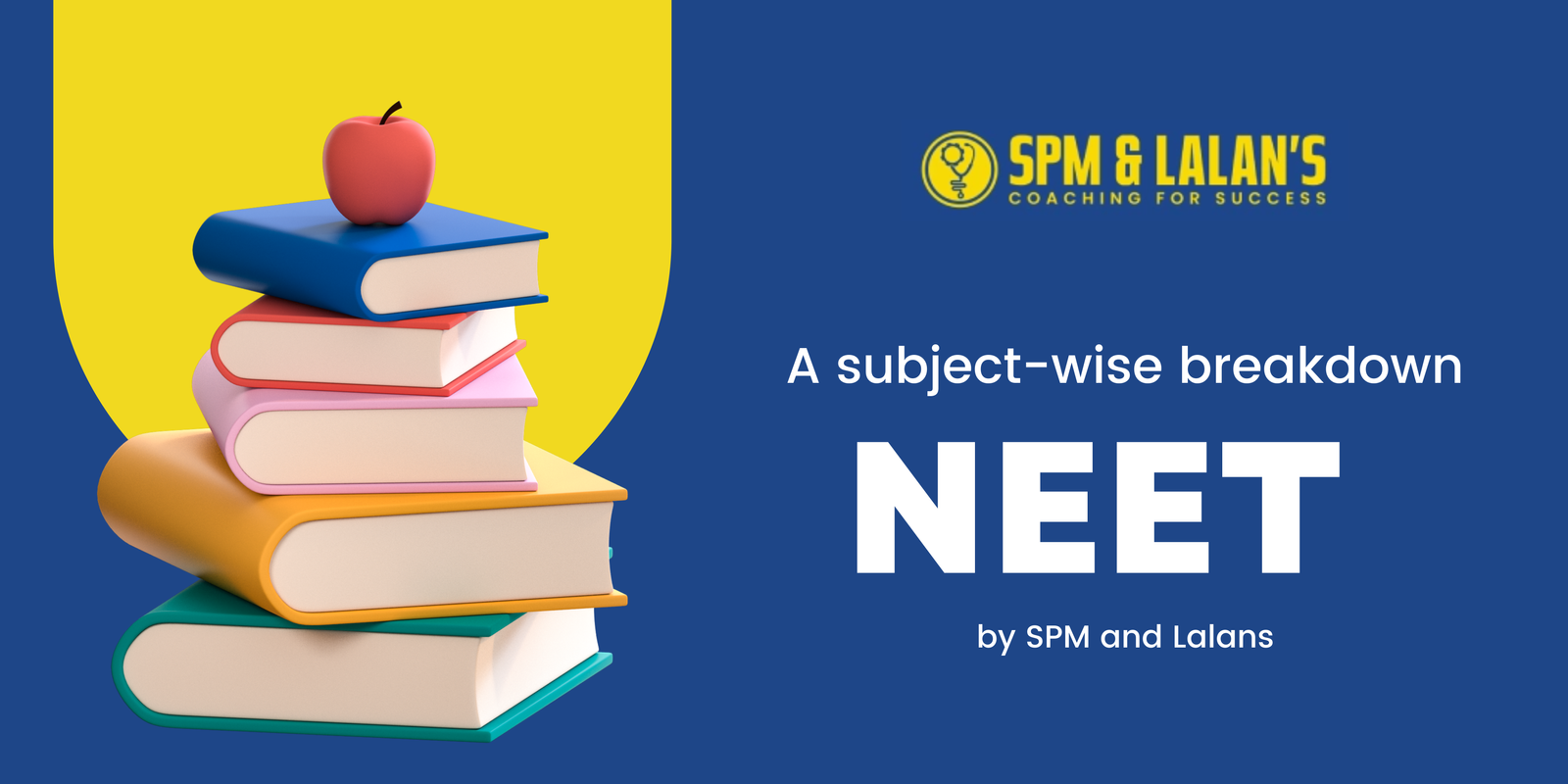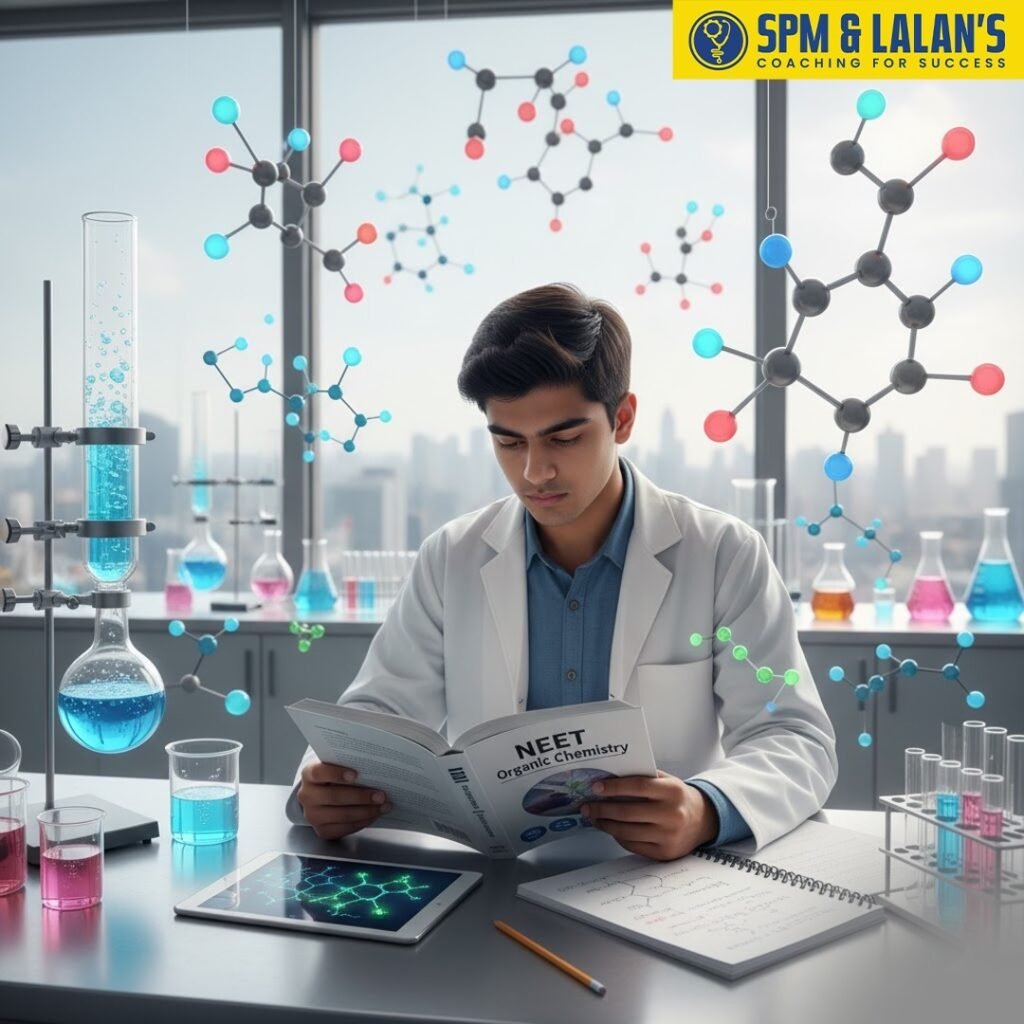
NEET Chemistry Syllabus 2026 matters most for every serious NEET aspirant, and at SPM and Lalan’s Coaching, we guide you step-by-step so you score high. The NEET Chemistry Syllabus includes topics from both Class 11 and Class 12, and it is divided into three main parts: Physical Chemistry, Organic Chemistry, and Inorganic Chemistry, so you must build strong concepts and practice regularly. Furthermore, the NEET Chemistry Syllabus 2026 is expected to remain the same as the NEET 2025 until the NTA issues an official update; therefore, you should begin preparation using the 2025 syllabus right away.
Quick summary
NEET Chemistry Syllabus 2026: NEET Chemistry is an important part of the NEET exam. It includes topics from both Class 11 and Class 12. The syllabus has three main parts: Physical Chemistry, Organic Chemistry, and Inorganic Chemistry. To do well in NEET, students need to understand the concepts and know how to apply them.
As of now, the official NEET 2026 syllabus has not been released by the National Testing Agency (NTA). However, the NEET 2025 syllabus did not have any changes, so it is expected that the NEET 2026 syllabus will also remain the same. Until the official notice is out, students can start preparing by following the 2025 NEET Chemistry syllabus.
NEET Chemistry Syllabus 2026 — Overview
NEET Chemistry Syllabus demands that you learn NCERT thoroughly, and at SPM and Lalan’s Coaching, we make sure you follow NCERT for both Class 11 and Class 12. The NEET Chemistry Syllabus covers Physical Chemistry, Organic Chemistry, and Inorganic Chemistry, and each section tests different skills: calculation and reasoning in Physical Chemistry, conceptual clarity and mechanisms in Organic Chemistry, and factual recall plus conceptual links in Inorganic Chemistry. Therefore, balance your study time to cover theory, numerical practice, and memory work.
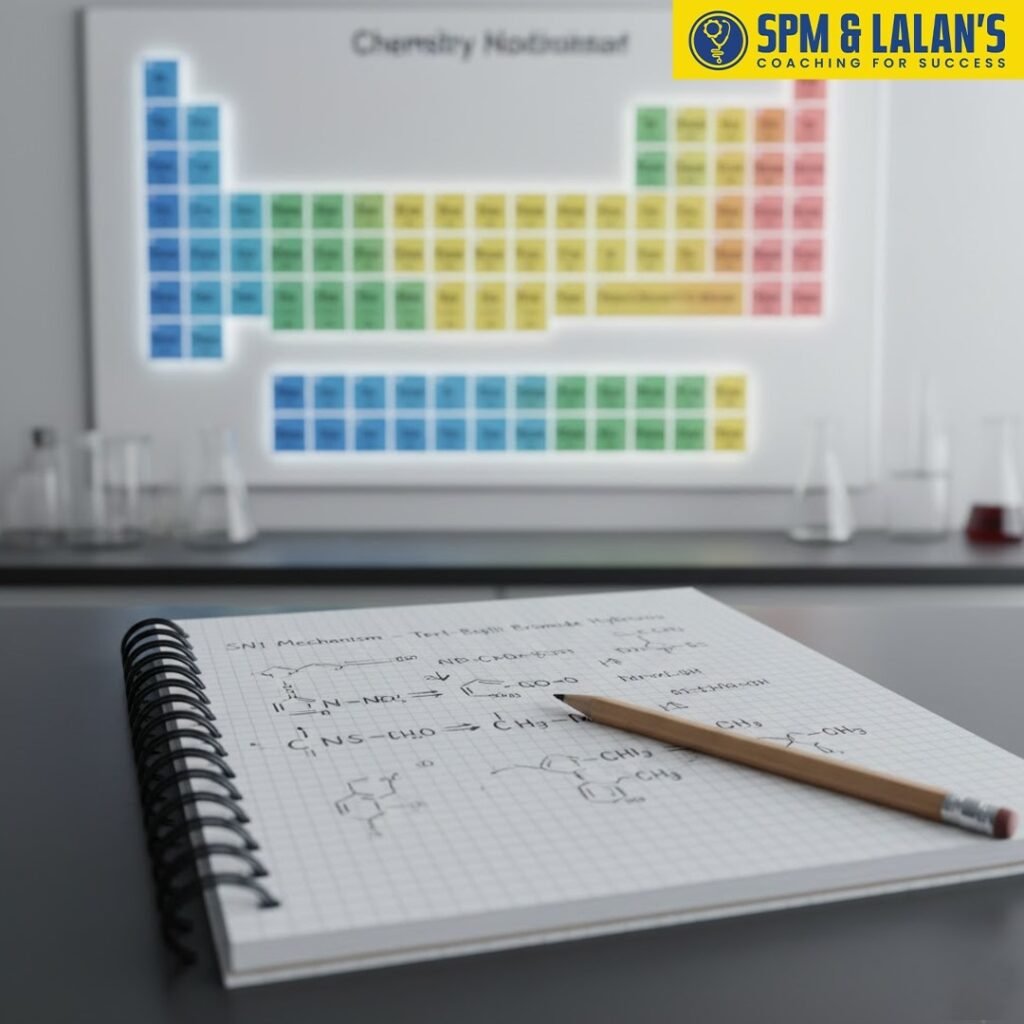
NEET Chemistry Syllabus 2026 — Class 11 (Table)
NEET Chemistry Syllabus for Class 11 includes foundational chapters that build up Class 12 understanding, and you must master these early.
Here is the complete syllabus:
| Chapter Name | Topics |
| Some Basic Concepts of Chemistry | Mole Concept, Determination of Formula of Compound, Stoichiometric Calculations, Concentration Terms, Relation Between Molarity and Normality |
| Redox Reactions | Oxidation Number, Redox Reactions, Balancing of Redox Reactions, Electrochemical Cell |
| Structure of Atom | Subatomic Particles, Concept of Atomic Number and Mass Number, Bohr’s Model of an Atom, Particle Nature of Electromagnetic Radiation, Photoelectric Effect, Quantum Mechanical Model, Quantum Numbers, Electronic Configuration of Atoms |
| Thermodynamics | P-V Work, Heat Capacity, Thermochemistry, Second Law of Thermodynamics |
| Equilibrium | Applications of Equilibrium Constant, Equilibrium Constant, Factors Affecting State of Equilibrium, Expressing Hydrogen Ion Concentration, Buffer Solution, Solubility of Sparingly Soluble Salts |
| Organic Chemistry – Some Basic Principles and Techniques | Naming the Organic Compounds, Isomerism in Organic Compounds, Electronic Displacements in Covalent Compounds, Reaction Intermediates, Hybridisation |
| Hydrocarbons | Conformations of Hydrocarbons, Isomerism in Alkenes, Stability of Alkene, Chemical Reactions of Alkenes, Chemical Reactions of Alkynes, Aromatic Hydrocarbons, Chemical Reactions of Aromatic Hydrocarbons |
| Classification of Elements and Periodicity in Properties | Modern Periodic Table, Periodic Trends in Properties of Elements |
| Chemical Bonding and Molecular Structure | General Introduction, Polarity of Bonds, Covalent Character in Ionic Bonds, Geometry or Shapes of Molecules, Concept of Orbital Overlap in Covalent Bonds, Molecular Orbital Theory (MOT), Hydrogen Bond |
| Principles Related To Practical Organic Chemistry | Analysis of Organic Compounds, Volumetric Analysis, Qualitative Salt Analysis, Enthapy |
| The p-Block Elements Part 1 | Group-13 Elements, Group-14 Elements |
NEET Chemistry Syllabus 2026 — Class 12 (Table)
NEET Chemistry Syllabus for Class 12 emphasizes advanced topics; therefore, you must focus on application and problem solving.
| Chapter (Class 12) | Topics |
| Solutions | Solubility of Gases in Liquids, Vapour Pressure of Liquid Solutions, Colligative Properties, Abnormal Molar Masses |
| Chemical Kinetics | Dependence of Reaction Rate on Concentration, Integrated Rate Expressions, Dependence of Reaction Rate on Temperature |
| Electrochemistry | Electrolytic Conduction, Variation of Conductivity and Molar Conductivity with Concentration, Kohlrausch’s Law, Electrochemical or Galvanic Cell, Electrochemical Series, Dependence of Cell and Electrode Potentials on Concentration, Electrolytic Cells and Electrolysis, Fuel Cells |
| Haloalkanes and Haloarenes | Chemical Properties of Haloalkanes, Chemical Properties of Haloarenes, Polyhalogen Compounds |
| Aldehydes, Ketones, and Carboxylic Acids | Alcohols: Reactions Involving Cleavage of (O-H) Bond, Alcohols: Reactions Involving Cleavage of (C-O) Bond, Alcohols: Reactions Involving Cleavage of Both Alkyl & Hydroxyl Groups, Phenols: Reactions of Phenolic Group, Phenols: Reactions of Benzene Ring, Phenols: Special Reactions, Distinction Between Alcohols and Phenols |
| Aldehydes, Ketones and Carboxylic Acids | Aldehydes & Ketones: Nucleophilic Addition Reactions, Aldehydes & Ketones: Oxidation Reactions, Aldehydes & Ketones: Reduction Reactions, Aldehydes & Ketones: Reaction with Base, Carboxylic Acids |
| Amines | Preparation Methods, Chemical Properties, Ring Substitution in Aromatic Amines, Distinction Between Amines |
| Biomolecules | Glucose and Fructose, Glucose: Reaction Due to Open Chain Structure, Disaccharides, Proteins, Nucleic Acids |
| Coordination Compounds | Ligands, Werner’s Theory, Coordination Compounds, Isomerism in Coordination Compounds, Bonding in Coordination Compounds |
| The d- and f- Block Elements | Introduction, General Properties of Transition Elements, Compounds of Transition Metals, Inner Transition Elements (Lanthanoids), Inner Transition Elements (Actinoids) |
| The p-Block Elements Part 2 | Group-15 Elements, Group-16 Elements, Group-17 Elements, Group-18 Elements |
Section-wise breakdown: Physical Chemistry (NEET Chemistry Syllabus)
NEET Chemistry Syllabus requires you to solve many numerical problems in Physical Chemistry; thus, you should practice daily. Therefore, Topics include Basic Concepts, States of Matter (gases/liquids), Thermodynamics, Chemical Equilibrium, Ionic Equilibrium, Redox, Chemical Kinetics, Electrochemistry, Surface Chemistry, and Solutions. Consequently, allocate time for numerical problem sets, formula sheets, and quick revision notes for the NEET Chemistry Syllabus.
NEET Chemistry Syllabus 2026 — Chapter-wise weightage & strategy
The NEET Chemistry Syllabus shows that examiners draw from both classes; therefore, you must prioritize topics that carry higher weight. Organic Chemistry (aromatic compounds, carbonyls), Chemical Kinetics, Coordination Compounds, and Chemical Bonding often give more questions, so practice those chapters first. Moreover, we at SPM and Lalan’s (Ghy) provide chapter-wise tests and shortlists that align with the NEET Chemistry Syllabus so you can focus on high-yield chapters and track progress.
| Topics | Sub-Topics |
| Basic Concepts of Chemistry | Atomic structure, Elements, and Classification of Elements |
| States of Matter: Gases and Liquids | Kinetic theory, Real gases, Liquid State |
| Thermodynamics | Thermodynamic system, Work, Heat, First Law of Thermodynamics, Enthalpy, Second Law of Thermodynamics, Gibbs Energy, Entropy, Gibbs-Helmholtz equation, Spontaneity and Equilibrium, Clausius inequality, Thermochemistry |
| Chemical Equilibrium | Law of mass action, Le Chatelier’s principle, Ionization of acids and bases, Buffer solutions, Solubility product, Common ion effect, pH scale, Hydrolysis of salts |
| Redox Reactions | Balancing of redox reactions, Electrochemical series, Nernst equation, EMF of a cell, Fuel cells, Corrosion, Electrolysis |
| Chemical Kinetics | Rate of reaction, Factors influencing the rate of a reaction, Arrhenius equation, Collision theory, Catalysis |
| Surface Chemistry | Adsorption, Colloids, Emulsions, Micelles |
| Classification of Elements and Periodicity | Periodic table, Trends in properties of elements, Electronic configuration, Ionization energy, Electronegativity |
| Hydrogen | Position in periodic table, Isotopes, Preparation, Properties, Uses, Hydrides |
| s-Block Elements | Alkali metals, Alkaline earth metals |
| p-Block Elements | Boron family, Carbon family, Nitrogen family, Oxygen family, Halogens, Noble gases |
| d- and f- Block Elements | Transition metals, Inner transition metals |
| Coordination Compounds | Nomenclature, Isomerism, Bonding in coordination compounds, Werner’s theory, Valence bond theory, Crystal field theory |
| Purification and Characterization of Organic Compounds | Purification methods, Qualitative analysis, Quantitative analysis, Determination of molecular formula, NMR, Mass spectrometry, Chromatography |
| Some Basic Principles of Organic Chemistry | Electronic displacements in a covalent bond, Types of organic reactions, Inductive effect, Resonance, Hyperconjugation, Tautomerism, Stereochemistry |
| Hydrocarbons | Alkanes, Alkenes, Alkynes, Aromatic hydrocarbons |
| Environmental Chemistry | Environmental pollutants, Green chemistry |
NEET Organic Chemistry Syllabus 2026
The Organic Part of the NEET Chemistry Syllabus 2026 deals with the study of carbon compounds, their structures, and reactions. Students must understand mechanisms, functional groups, and synthesis pathways to excel. Moreover, this section tests both theoretical understanding and practical application, making it one of the most dynamic portions of the paper.
| Topics | Sub-Topics |
| Basic Principles of Organic Chemistry | Tetravalency of Carbon, Shapes of Organic Molecules, Hybridization, Isomerism, Resonance, Hyperconjugation, Inductive and Electromeric Effects, Acid-Base Concepts in Organic Chemistry |
| Hydrocarbons | Alkanes, Alkenes, Alkynes, Aromatic Hydrocarbons, Mechanism of Electrophilic Substitution, Methods of Preparation and Properties |
| Organic Compounds Containing Halogens | Haloalkanes and Haloarenes, Nomenclature, Nature of C-X bond, Methods of Preparation, Physical and Chemical Properties, Uses |
| Organic Compounds Containing Oxygen | Alcohols, Phenols, Ethers, Aldehydes, Ketones, Carboxylic Acids, Acid Derivatives, Esterification, Oxidation-Reduction, Williamson Synthesis, Reimer-Tiemann Reaction, Clemmensen Reduction |
| Organic Compounds Containing Nitrogen | Amines, Classification, Nomenclature, Structure, Basicity of Amines, Preparation, Physical and Chemical Properties, Diazonium Salts and their Chemical Reactions, Hofmann’s Bromamide Reaction |
| Polymers | Classification, Types, General Methods of Polymerization, Copolymerization, Some Important Polymers and their Monomers, Biodegradable Polymers, Conducting Polymers |
| Biomolecules | Carbohydrates, Proteins, Vitamins, Nucleic Acids, Hormones, Enzymes |
| Chemistry in Everyday Life | Drugs and their Classification, Therapeutic Action of Different Classes of Drugs, Chemicals in Food, Cleansing Agents |
| Principles Related to Practical Chemistry | Detection of Elements (N, S, Halogens), Detection of Functional Groups (Nitro, Cyanide, Carbonyl, Aromaticity), Detection of Carbohydrates and Fats in Food |
NEET Inorganic Chemistry Syllabus 2026
In the Inorganic part of the NEET Chemistry Syllabus 2026, it is closely connected with Inorganic Chemistry, as both sections require understanding periodicity and element behavior. Moreover, Inorganic Chemistry covers the d- and f-Block Elements, Coordination Compounds, and Periodic Properties, demanding conceptual clarity and strong memorization skills.
| Topic | Sub-Topics |
| Classification of Elements and Periodicity | Modern periodic table, Electronic configuration, Trends in properties, Periodic trends in physical and chemical properties |
| General Principles and Processes of Isolation of Metals | Principles of metallurgy, Occurrence of metals, Extraction of metals, Enrichment of ores, Extractive metallurgy of common metals |
| Hydrogen | Position in the periodic table, Isotopes, Preparation, Properties, Uses, Hydrides |
| s-Block Elements | Alkali metals, Alkaline earth metals |
| p-Block Elements | Boron family, Carbon family, Nitrogen family, Oxygen family, Halogens, Noble gases |
| d- and f-Block Elements | Transition metals, Inner transition metals |
| Coordination Compounds | Nomenclature, Isomerism, Bonding in coordination compounds, Werner’s theory, Valence bond theory, Crystal field theory |
| Environmental Chemistry | Environmental pollutants, Green chemistry |
NEET Chemistry Syllabus 2026 Analysis
In the previous NEET exam, the Chemistry section was moderately difficult. Questions were evenly distributed among Physical, Organic, and Inorganic Chemistry. Most of the questions were directly derived from NCERT textbooks, highlighting the importance of mastering the Syllabus 2026 and related chapters from the official syllabus.
Here is the Chapter-Wise NEET Chemistry Weightage (Based on 2025 Trends)
| Class | Chapter Name | No. of Questions |
| 11th | Aldehydes, Ketones, and Carboxylic Acids | 2 |
| 11th | Classification of Elements and Periodicity in Properties | 2 |
| 11th | Hydrocarbons | 3 |
| 11th | Some Basic Concepts of Chemistry | 2 |
| 11th | Redox Reactions | 1 |
| 11th | Organic Chemistry: Some Basic Principles and Techniques | 4 |
| 11th | Equilibrium | 3 |
| 11th | Chemical Bonding and Molecular Structure | 2 |
| 11th | Thermodynamics | 1 |
| 12th | Biomolecules | 2 |
| 12th | Principles of Qualitative Analysis | 1 |
| 12th | Coordination Compounds | 4 |
| 12th | The p-Block Elements (XII) | 2 |
| 12th | Chemical Kinetics | 3 |
| 12th | Electrochemistry | 1 |
| 12th | Solutions | 3 |
| 12th | Amines | 2 |
| 12th | Alcohols, Phenols, and Ethers | 3 |
| 12th | The d and f-Block Elements | 1 |
| 12th | Haloalkanes and Haloarenes | 2 |
| 12th | Alcohols, Phenols and Ethers | 1 |
| Total | 45 |
Hence, this weightage shows that a large portion of the paper stems from Syllabus 2026, reinforcing its importance for a high score.
NEET Chemistry Chapter-wise Weightage 2026
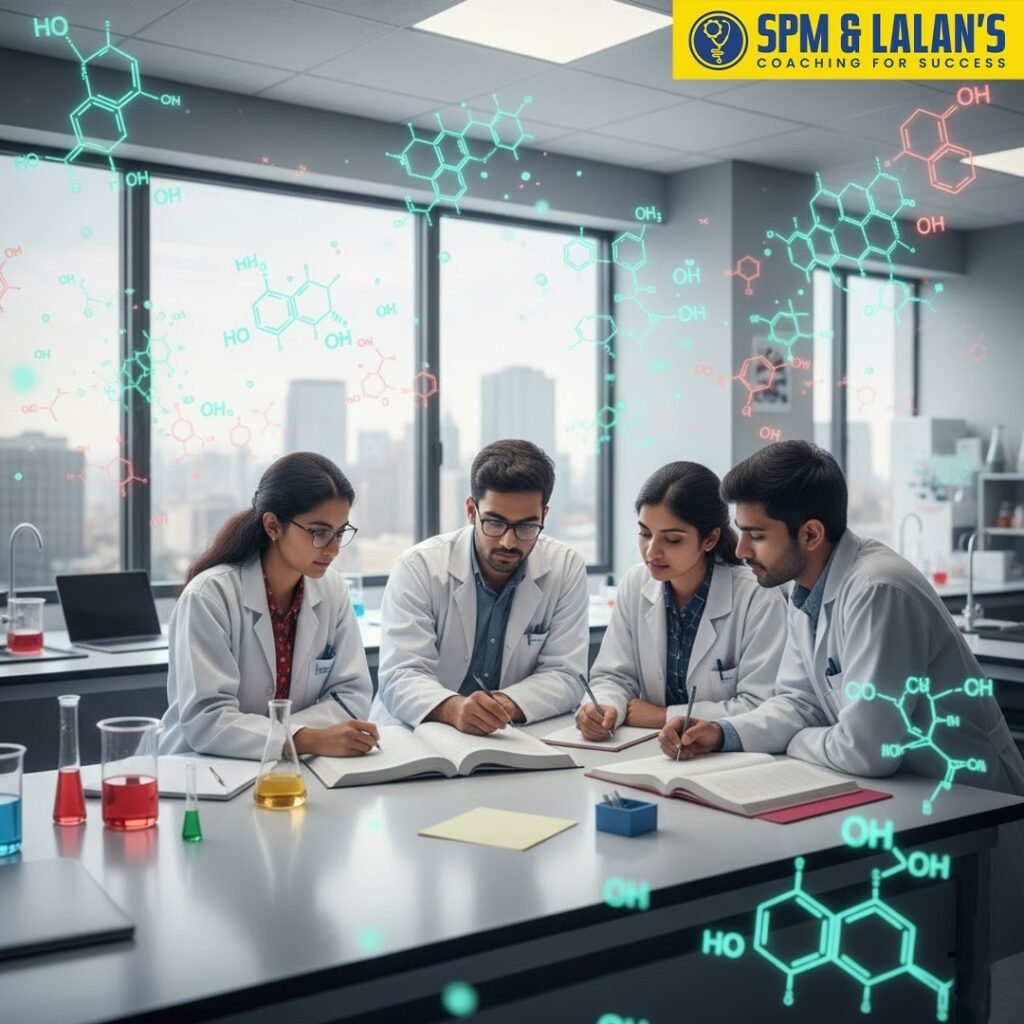
Understanding chapter-wise weightage helps prioritize topics effectively. Therefore , the Organic Chemistry topics such as Aldehydes, Ketones, Hydrocarbons, and Aromatic Compounds hold significant importance.
Here is the NEET Chemistry Chapter-wise Weightage 2026 ( Physical )
| Class | Chapter Name | Average Number of Questions | Weightage |
| Class XI | Mole Concept | 2 | 5% |
| Class XI | Atomic Structure & Nuclear Chemistry | 1 | 3% |
| Class XI | Gaseous State | 1 | 3% |
| Class XI | Thermodynamics & Thermochemistry | 1 | 3% |
| Class XI | Chemical Equilibrium | 1 | 3% |
| Class XI | Ionic Equilibrium | 2 | 4% |
| Class XI | Redox Reactions | 1 | 2% |
| Class XII | Solid State | 1 | 3% |
| Class XII | Solutions & Colligative Properties | 2 | 4% |
| Class XII | Electrochemistry | 1 | 3% |
| Class XII | Chemical Kinetics | 2 | 4% |
| Class XII | Surface Chemistry | 1 | 2% |
NEET Chemistry Chapter-wise Weightage 2026 ( Organic )
| Class XI | Hydrocarbons | 2 | 4% |
| Class XI | General Organic Chemistry | 2 | 5% |
| Class XII | Haloalkane | 1 | 2% |
| Class XII | Aldehydes, Ketones, and Carboxylic Acids | 2 | 3% |
| Class XII | Polymer | 1 | 2% |
| Class XII | Alcohol, Phenol, Alkyl Halide | 2 | 4% |
| Class XII | Aromatic Compounds | 3 | 6% |
| Class XII | Biomolecules | 2 | 4% |
| Class XII | Carbonyl Compounds | 2 | 4% |
| Class XII | Organic Compounds comprising Nitrogen | 2 | 3% |
| Class XII | Chemistry in Everyday Life | 2 | 3% |
| Class XII | Environmental Chemistry | 1 | 2% |
| Class XII | IUPAC & Isomerism | 2 | 4% |
| Class XII | Practical Organic Chemistry | 1 | 2% |
NEET Chemistry Chapter-wise Weightage 2026 ( Inorganic )
| Class XI | Chemical Bonding | 4 | 9% |
| Class XI | P-Block Elements | 3 | 7% |
| Class XI | Periodic Table & Periodicity in Properties | 2 | 4% |
| Class XI | Hydrogen | 1 | 2% |
| Class XI | S-Block Elements | 1 | 3% |
| Class XII | Coordination Compounds | 3 | 6% |
| Class XII | D and F-Block Elements | 2 | 4% |
| Class XII | Metallurgy | 1 | 2% |
| Class XII | Qualitative Analysis | 1 | 2% |
Hence , This data indicates the part wise weightage of the syllabus 2026 of the total Chemistry section, making it indispensable for aspirants.
What are the Important Topics from the syllabus
Some high-scoring areas from the Syllabus 2026 include:
- First, Aldehydes, Ketones, and Carboxylic Acids
- Second, Hydrocarbons
- Third , Amines
- Fourth, the Biomolecules
- Coordination Compounds
- Chemical Kinetics
- Lastly, the Electrochemistry
Hence, focusing on these chapters ensures maximum returns for your preparation efforts.
NEET Chemistry Important Topics for Class 11 (Organic Section)
| Class 11 Chapters | Topics |
| Some Basic Concepts of Chemistry | Mole Concept Determination of the Formula of a Compound Stoichiometric Calculations Concentration Terms Relation Between Molarity and Normality |
| Redox Reactions | Oxidation Number Redox Reactions Balancing of Redox Reactions Electrochemical Cell Redox Reactions |
| Structure of Atom | Subatomic Particles Concept of Atomic Number and Mass Number Bohr’s Model of an Atom Particle Nature of Electromagnetic Radiation Photoelectric Effect Quantum Mechanical Model Quantum Numbers Electronic Configuration of Atoms |
| Thermodynamics | P-V Work Heat Capacity Thermochemistry Second Law of Thermodynamics |
| Equilibrium | Applications of Equilibrium Constant Equilibrium Constant Factors Affecting the State of Equilibrium Expressing Hydrogen Ion Concentration Buffer Solution Solubility of Sparingly Soluble Salts |
| Organic Chemistry – Some Basic Principles and Techniques | Naming the Organic Compounds Isomerism in Organic Compounds Electronic Displacement in Covalent Compounds Reaction Intermediates Hybridization |
| Hydrocarbons | Conformations of Hydrocarbons Isomerism in Alkenes Stability of Alkene Chemical Reactions of Alkenes Aromatic Hydrocarbons Chemical Reactions of Aromatic Hydrocarbons |
| Classification of Elements and Periodicity in Properties | Modern Periodic Table Periodic Trends in Properties of Elements |
| Chemical Bonding and Molecular Structure | General Introduction Polarity of Bonds Covalent Character in Ionic Bonds Geometry or Shapes of Molecules Concept of Orbital Overlap in Covalent Bonds Molecular Orbital Theory (MOT) Hydrogen Bond |
| Principles Related To Practical Organic Chemistry | Analysis of Organic Compounds Volumetric Analysis Qualitative Salt Analysis Enthapy |
| The p-Block Elements Part 1 | Group-13 Elements Group-14 Elements |
Hence, these foundational chapters are the backbone of the Syllabus 2026, helping students tackle Class 12 topics with ease.
NEET Chemistry Important Topics for Class 12 (Organic Section)
| Chapter | Key Topics |
| Solutions | Solubility of Gases in Liquids Vapour Pressure of Liquid Solutions Colligative Properties Abnormal Molar Masses |
| Chemical Kinetics | Dependence of Reaction Rate on Concentration Integrated Rate Expressions Dependence of Reaction Rate on Temperature |
| Electrochemistry | Electrolytic Conduction Variation of Conductivity and Molar Conductivity with Concentration Kohlrausch’s Law Electrochemical or Galvanic Cell Electrochemical Series Dependence of Cell and Electrode Potentials on Concentration” Electrolytic Cells and Electrolysis Fuel Cells |
| Haloalkanes and Haloarenes | Chemical Properties of Haloarenes Polyhalogen Compounds |
| Alcohols, Phenols and Ethers | Alcohols: Reactions Involving Cleavage of (O-H) Bond Alcohols: Reactions Involving Cleavage of (C-O) Bond Alcohols: Reactions Involving Cleavage of Both Alkyl & Hydroxyl Groups Phenols: Reactions of the Phenolic Group Phenols: Reactions of the Benzene Ring Phenols: Special Reactions Distinction Between Alcohols and Phenols |
| Aldehydes, Ketones and Carboxylic Acids | Aldehydes & Ketones: Nucleophilic Addition ReactionsAldehydes & Ketones: Oxidation ReactionsAldehydes & Ketones: Reduction ReactionsCarboxylic Acids |
| Amines | Preparation Methods Chemical Properties Ring Substitution in Aromatic Amines Distinction Between Amines |
| Biomolecules | Glucose and Fructose Glucose: Reaction Due to Open Chain Structure Disaccharides Proteins Nucleic Acids |
| Coordination Compounds | Ligands Werner’s Theory Coordination Compounds Isomerism in Coordination Compounds Bonding in Coordination Compounds |
| The d- and f- Block Elements | Introduction General Properties of Transition Elements Compounds of Transition Metals Inner Transition Elements (Lanthanoids) Inner Transition Elements (Actinoids) |
| The p-Block Elements Part 2 | Group-15 Elements Group-16 Elements Group-17 Elements Group-18 Elements |
Hence, these advanced topics from Syllabus 2026 are crucial for conceptual and numerical mastery.
How SPM and Lalan’s (Ghy) trains you on the NEET Chemistry Syllabus
SPM and Lalan’s (Ghy) builds your NEET Chemistry Syllabus mastery through concept classes, problem-solving sessions, weekly tests, and doubt clinics; consequently, you will develop speed and accuracy. Moreover, we emphasize the NCERT-first approach, targeted revision notes, mnemonic devices for inorganic chemistry, and mechanism drills for organic chemistry so you meet the Chemistry Syllabus demands on exam day.
Quick study plan (8-week focus) for NEET Chemistry Syllabus
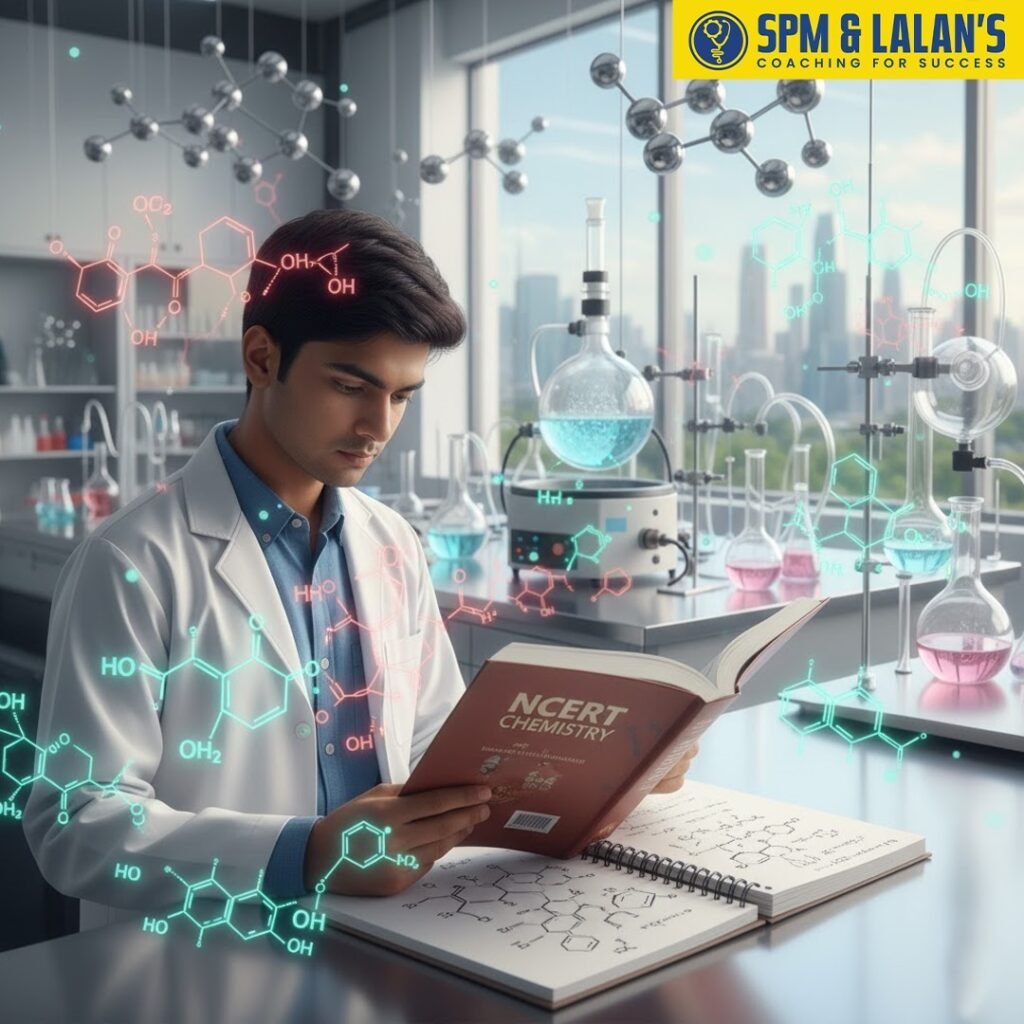
- Week 1–2: First, try to finish NCERT Class 11 chapters in Physical and Organic sections and solve 200 practice questions covering the Chemistry Syllabus.
- Week 3–4: Secondly, Finish NCERT Class 12 core chapters (Electrochemistry, Kinetics, Coordination) and practice time-bound tests aligned to the Chemistry Syllabus.
- Week 5–6: Third, always revise Inorganic charts, memorize periodic trends, and solve previous years’ NEET questions mapped to the Chemistry Syllabus.
- Week 7–8: Fourth, take full-length mock tests, analyze weak areas, and revise formula sheets for the Chemistry Syllabus.
Conclusion
Prepare smartly using the Chemistry Syllabus, and follow NCERT thoroughly while supplementing with objective practice, because the NEET Chemistry Syllabus rewards concept clarity and repeated question practice. Hence, at SPM and Lalan’s, we guide students through a focused plan, regular tests, and targeted revision so you convert effort into marks and master the Chemistry Syllabus 2026.



